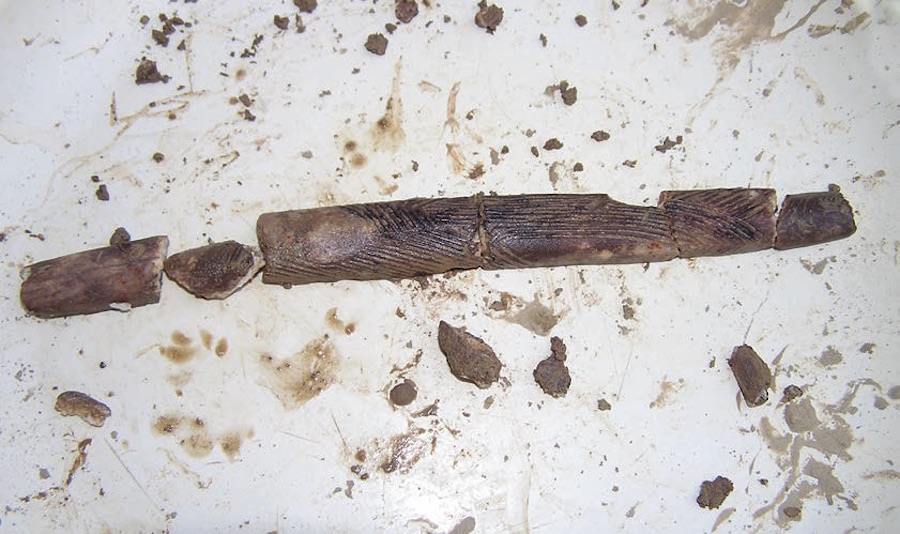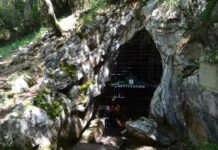A few days ago, we came across an article on several sites about a study carried out by a group of Basque scientists on several Magdalenian sticks found a few years ago in Ezkurtza Cave.
The work was reported by archaeology and anthropology website Munibe, which is published by the Aranzadi Sciences Society (which we’ve spoken about before).
The scientific article, which we found highly interesting, describes the three “Magdalenian sticks” that have been found in the Ezkuzta Cave in Azpeitia, Gipuzkoa since 2014, and places them in their timeframe and style.
As we are completely inexpert on these matters, an article like this is great for understanding that time period and the inhabitants of this part of Europe who moved about and had relationships with other communities. As for what we’ve read, we remembered another study we wrote about, also carried out by the Aranzadi Sciences Society, which by analyzing a campsite from 25,000 years ago in modern-day San Sebastian explained what the economic territory these nomadic societies exploited, based on the information offered by a flint chosen to carry out their stone age work.
So far, so fascinating. But even more fascinating is the “political” introduction the EFE journalist added to the scientific part of the news.
He claims that the sticks were “forgotten by a group of modern humans who crossed the Pyrenees from France and moved into the peninsula (las dejaron olvidadas un grupo de humanos modernos que cruzó los Pirineos desde Francia, y se internó en la península)”. Absolutely nobody at all knows if they were “forgotten”, or an offering, or a “breadcrumb” left to mark their presence there. It’s hard to imagine that in those times, anything that had been hunted, or a piece of a tool like flint, would be casually forgotten, given their worth.
Seeing other reports on the movements and lifestyle of these people, it doesn’t seem like that that place was strange to them. It’s more likely that they might have been a part of a stopover point or shelter while hunting or carrying out other activities.
And “France”? Really? It would seem that for some, the modern-nation state has always existed in Europe.
At that time, in the last ice age, there were a group of human beings who shared a territory, culture, and economic relations, in a space that covered both sides of the Pyrenees. None of that was France or Spain.
If a place name had to be given to these discoveries, then it should be specific enough. It ought to be made clear that this art form, the “Magdalenian sticks” or “Isturitzian sticks” come from the Isturitz Cave in modern-day Lower Navarre.
We’d also have to state that there are similar sticks of this time and from this time in other caves throughout Basque lands, as is the case with the Abauntz Cave (modern-day Upper Navarre), where, in addition to sticks, the oldest map in Western Europe was found, carved in stone.
If we have to relate it to something “current”, then it ought to be with the Basques. The only thing we know is that there are genetic studies that directly relate those prehistoric peoples with the people who now currently live in our country.
We’re sure many are going to think that we’re a bit too thin-skinned on these matters, but it’s just that the language used by EFE is the consequence of a deterministic idea of History: “Spain and France existed even though the then-current inhabitants of those lands didn’t know it”. Or, if you prefer a less radical version, “Spain and France are the consequence of the inevitable flow of History”.
And that is just not true.
We’ll leave you with the article in the Ecuatorial daily El Mercurio that we found, and the study carried out by Ignacio BARANDIARÁN Ana CAVA, Alvaro ARRIZABALAGA, and María-José IRIARTE-CHIAPUSSO and published in Vol. 70 of the Aranzadi Science Society’s “Munibe” journal.
El Mercurio – 2/2/2020 – Ecuador
El misterio de las varillas magdalenienses olvidadas en Gipuzkoa
Hace entre 14.000 y 14.500 años, en pleno período Magdaleniense, cuando los neandertales llevaban ya más de 20.000 años extintos, un grupo de humanos modernos cruzó los Pirineos desde Francia, se internó en la península y olvidó en una cueva de Azpeitia (Gipuzkoa) tres varillas de asta decoradas que se han convertido en un verdadero misterio para los arqueólogos.
(Follow) (Automatic translation)
Header image: Original condition of stick 3 when it was discovered (photo: Antxieta Arkeologia Taldea).
Last Updated on Apr 18, 2021 by About Basque Country































